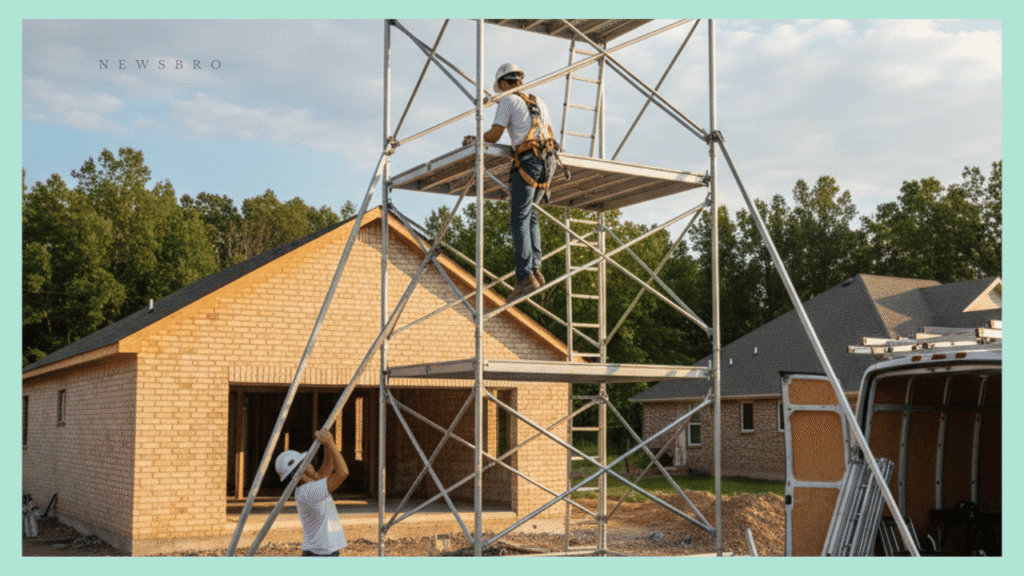Scaffold towers make work at height safer and more efficient — when they’re sized correctly, built properly, and used on the right ground. This guide gives you the essentials so you can book the right kit, brief your team, and get the job done without surprises.
TL;DR (for busy teams)
- Pick the right type and height for the task and access route.
- Level, solid ground only — plan stabilisers and baseplates.
- Work at Height Regulations apply — plan, supervise, and inspect.
- PASMA-trained people should build, move, and dismantle.
- Know your limits: wind, load, and where towers shouldn’t be used.
1) Choose the right tower for the job
Common options:
- Narrow-width for corridors and tight access
- Double-width for a larger working platform
- Staircase towers for multi-level sites or steps
- Cantilever/bridge for spanning obstacles
Measure properly: required platform height, access width/height, and any turns. Incorrect sizing causes delays and unsafe “make-do” setups.
2) Understand height (platform vs working)
- Platform height is where your feet stand.
- Working height ≈ platform height + user’s height + arm reach.
Typical guidance: up to ~12 m outdoors and ~15 m indoors (model and site-dependent). Never overreach; reposition the tower instead when you rent scaffold tower equipment.
3) Prepare the ground before delivery
Check that your setup area is:
- Level and firm (no soft spots, covers, voids, or trenches)
- Clear for delivery (route, doors, lifts, corners)
- Rated for the floor loading near atriums/voids
Use outriggers/stabilisers and baseplates as specified. Ground issues are the biggest cause of instability.
4) Know your legal responsibilities
Under the Work at Height Regulations 2005, you must:
- Plan the work and select suitable equipment
- Prevent falls (guardrails, toe boards, gates)
- Inspect the tower and keep records
If you rent it, you’re responsible for ensuring it’s erected correctly and used safely on your site.
5) Use PASMA-trained people
Erection, alteration, moving, and dismantling should be done by PASMA-trained personnel. Even if your team isn’t assembling it, give users a site induction and brief on exclusions and housekeeping.
6) Know the limitations (and when not to use a tower)
Great for stable, level indoor floors and good external hardstanding. Not suitable for:
- Uneven or soft ground (consider powered access or tracked platforms)
- Heavy loads (watch platform capacity)
- Long-term static works (fixed scaffold may be better)
- High winds — outdoors, stop at around 17 mph (7.5 m/s)
7) What’s included in the hire? (avoid surprises)
Confirm in writing:
- Delivery/collection windows and any off-hours costs
- Assembly: supplied or your team to build?
- Stabilisers, toe boards, access ladders included?
- Recent inspection status and manuals/user guides
- Support number for call-outs or missing parts
Quick RAMS/Pre-start checklist (copy/paste)
Access & space
□ Door and corridor widths/heights checked
□ Lift car size and rating (if applicable)
□ Route clear of steps/obstructions
Ground/floor
□ Level, firm, protected if needed
□ Floor loading verified near voids/edges
□ Stabilisers/baseplates specified
Tower setup
□ Correct height/type and platform capacity
□ Guardrails, toe boards, ladder/gate present
□ PASMA-trained team named and briefed
Use & supervision
□ Exclusion zone marked (cones/barriers)
□ Weather limits agreed (outdoors)
□ Daily pre-use checks recorded
Handover & close
□ Inspection log completed and signed
□ Housekeeping done; area left safe
□ Dismantle/collection booked
Expert tip
“Most tower incidents trace back to ground conditions or tweaks made after the fact. Build it right once, on solid ground, and make repositioning the default — never overreach.”
FAQs (snippet-friendly)
Do I need training to use a scaffold tower?
If you’re assembling, altering, moving, or dismantling, yes — PASMA training. Users still need a site briefing and supervision.
Can I put a tower on grass?
No. Grass compresses and shifts. Use only level, firm ground and the specified stabilisers/baseplates.
How long can I hire for?
From a single day to multiple weeks. Longer hires often have better day rates.
Are towers safe in windy conditions?
Outdoors, stop at roughly 17 mph (7.5 m/s). Indoors is more controlled, but follow the manufacturer’s instructions and fit stabilisers.
What’s the difference between platform and working height?
Working height includes the user’s standing height and reach. Size the tower so nobody has to lean or stretch.
Why teams choose towers for planned maintenance
- Fast, repeatable access with full guardrail protection
- Minimal disruption to public areas and workflow
- Cost-effective over multi-point routes compared with fixed scaffold
- Scalable: add/remove sections as the job evolves
Ready to book the right tower?
Share your task height, access photos, ground details, and schedule. We’ll match a PASMA-compliant tower, arrange delivery, and support your team from setup to sign-off.
Meta (for CMS)
- Primary keyword: scaffold tower
- Secondary keywords: PASMA training, Work at Height Regulations, tower hire, mobile access tower
- Search intent: pre-hire guidance & compliance
- Optimised for: GEO/AEO/SEO (clear headings, FAQs, checklist, snippet-ready copy)
- Region & spelling: UK / British English

